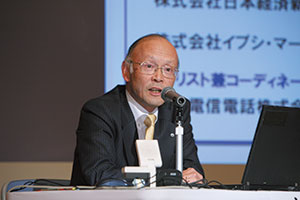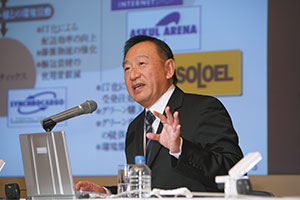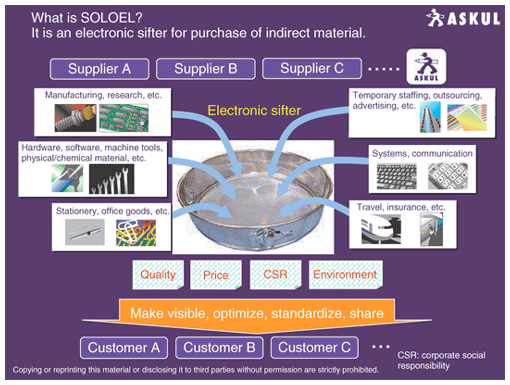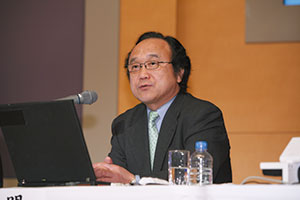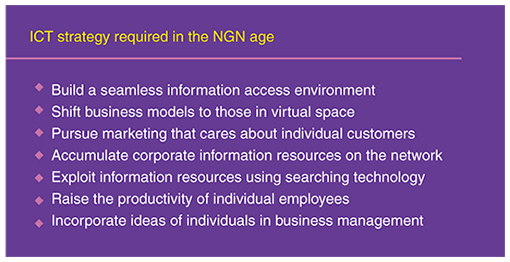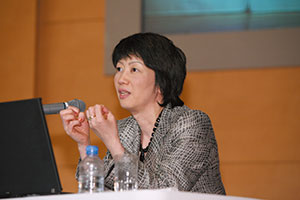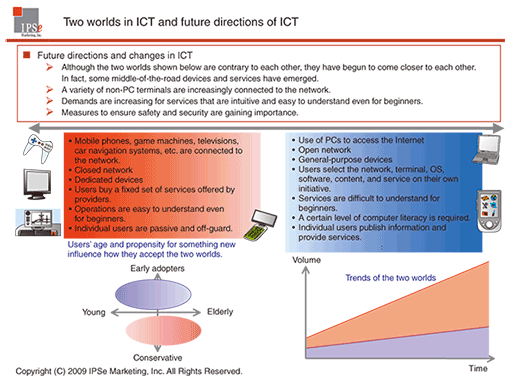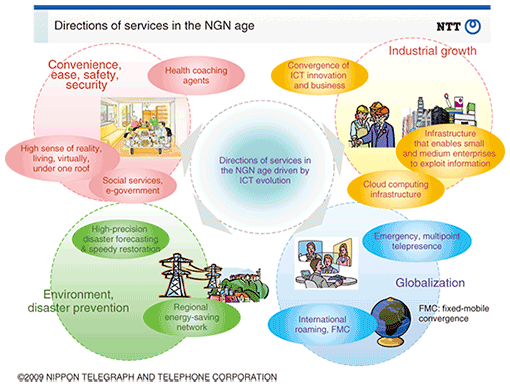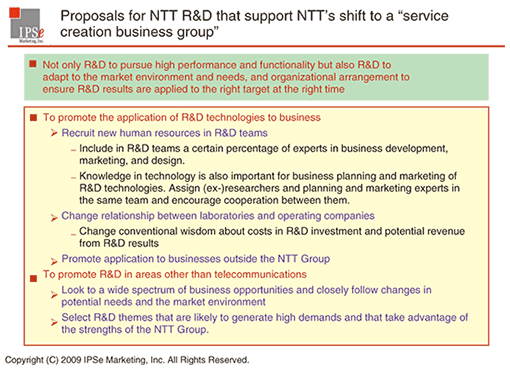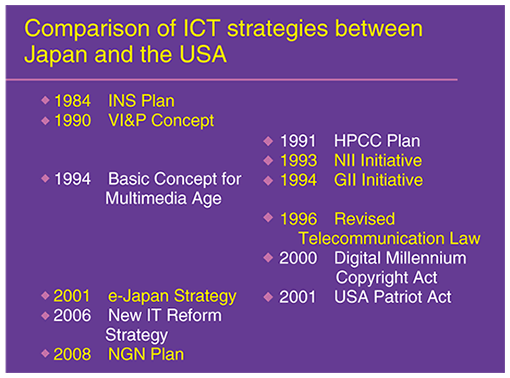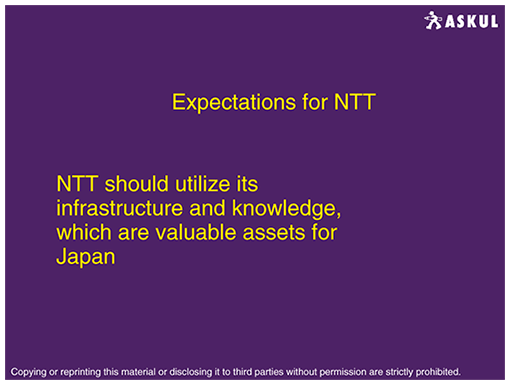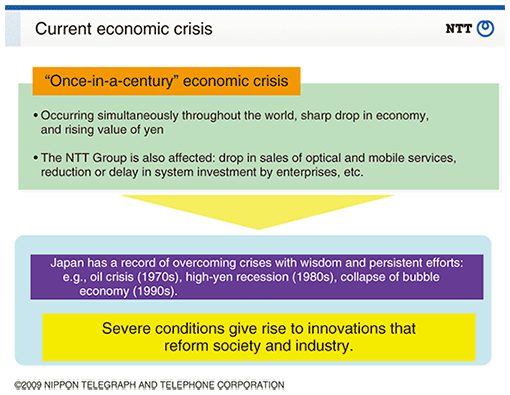 |
|||||||
|
|
|||||||
|
Special Feature: NTT R&D Forum 2009 Panel Discussion Vol. 7, No. 5, pp. 5–18, May 2009. https://doi.org/10.53829/ntr200905sf0 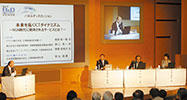 ICT Dynamism to Open New Horizons–– Services Required in the NGN AgePanelists:Coordinator:AbstractIn the NTT R&D Forum 2009 held on February 19–20, 2009, a panel discussion entitled “ICT Dynamism to Open New Horizons” was held. This article reports the discussion among the four panelists (one from NTT and three other invited personalities), which was coordinated by Noritaka Uji, Representative Director and Senior Executive Vice President of NTT, focusing on the direction in which information and communications technology (ICT) should evolve to contribute to society and on the consequent expectations for NTT. 1. Opening comments from Noritaka UjiI am pleased to hold a panel discussion today with three distinguished personalities in the field of information and communications technology (ICT) as panelists under the title “ICT Dynamism to Open New Horizons––What Services Does the NGN Age Require” (Photo 1). In the first part of this session, each panelist will give a position statement focusing on the direction in which ICT should evolve to contribute to society and on expectations for NTT, especially regarding the Next Generation Network (NGN). In the second part, we will hold a general discussion on these subjects.
2. Position statements by panelists2.1 Position statement by Shoichiro Iwata2.1.1 “Our next strategy for growth is to exploit ICT to develop a de facto standard for the purchase of indirect material.”I would like to talk about how enterprises actually exploit ICT to drive their growth, taking the case of my company, ASKUL, as an example (Photo 2). In ASKUL, the percentage of orders received via the Internet is increasing every year. By January 2009, it had exceeded 56%, which means that orders worth more than 100 billion yen (about US$ 1 billion) are placed annually via the Internet. We sell mainly stationery and other items used in offices. Although some products are bought regularly, the demand for each product varies enormously from week to week. We try to avoid running out of stock as well as holding excessive stock by forecasting the demand for each product at each distribution center and by providing the forecast data to suppliers over an ICT network. Indeed, our industry stands upon ICT foundations.
It is important to study how to coordinate orders received via the Internet and physical distribution. We have adopted the strategy of making the amount of our investment in ICT proportional to the volume of physical distribution. Although ASKUL has recorded steady growth over the last 15 years, we are aiming to transform our business model into one adapted to the next generation, so we are expanding our business to handle not only general stationery but also all types of indirect material (business support products). For this purpose, we are exerting considerable efforts to get our batch purchase system, called SOLOEL, accepted as a de facto standard for the purchase of indirect material (Fig. 1).
Conventionally, each department in an enterprise buys indirect material separately. SOLOEL enables such an enterprise to purchase all indirect material electronically and in a clearly visible manner. Internally, our company calls SOLOEL an electronic sifter or filter in the sense that goods are filtered before they are selected for purchase. The criteria for filtering are not limited to the quality and price of each product but include its traceability and environmental load to reflect the rise in importance of socially responsible procurement. The SOLOEL system is designed to make such procurement clearly visible and to standardize and optimize it. Finally, it allows multiple enterprises to consolidate their orders to reduce product costs. This has been made possible by adopting a SaaS (software as a service) mechanism. In doing this, it is important to incorporate into the SaaS mechanism various support functions, such as purchases on behalf of customers, consultation, and batch billing for both products and deliveries. It is important to make sure that customers do not feel forced to use the system, but rather than they use it willingly because it gives them a wider selection to choose from. When the system is used widely, the entire picture of their purchases will become clearly visible. Our objective is to make the system into an open and fair platform: a next-generation social infrastructure that will be built in a collaborative manner by all those concerned, regardless of whether they are customers, distributors, or suppliers. This is our strategy for future growth. 2.1.2 “Creation of an IT-innovation-driven industry”Last year, I served as the Chair of the “Committee for Social Changes Caused by IT” organized by the Association of Corporate Executives (IT: information technology). We discussed what role Japan should play if it is to serve as a global model for an economically advanced, mature country. We concluded that Japan’s role is to develop an industry driven by IT innovation based on a common IT platform in order to build a society that is efficient and friendly to everyone and that generates minimal environmental loads. The IT-innovation-driven industry is a new industry into which not only the conventional IT industry but also various other industries, from agriculture, forestry, fishing, and mining to services, should be transformed by IT innovation. The new network services proposed by NTT may provide exactly that common platform. I believe that the infrastructure and knowledge held by NTT are valuable assets to Japan and that together we should seek to fully exploit them to revitalize Japan. 2.2 Position statement by Waichi Sekiguchi2.2.1 “It is important to build a new ICT strategy to strengthen Japan’s international competitiveness.”As a journalist, I have been watching the world of information communication for the last 15 years or so (Photo 3). From this perspective, I would like to discuss what will be expected of the NGN.
The latest trend in Internet technology is information sharing via the network as symbolized by what is called Web2.0. Virtual communities are created, and commercial activities and intellectual and creative activities are conducted over this network. Such social web-related services accounted for more than half of the top ten services in the web access ranking in the USA in 2008. Against this background, let us consider how Japan fares. Since the country adopted the e-Japan strategy, it has been pressing forward to reinforce its ICT infrastructure. However, it is unfortunate that this infrastructure is not fully exploited. In the world’s competitiveness ranking, Japan was at the top until the mid-1990s, but over the last 15 years, as the information age was ushered in, Japan’s ranking fell steadily. It is considered that the delay in ICT usage in Japan may have been partially responsible for the fall in the country’s relative competitive edge. In light of this, let me point out three main issues that plague Japan’s ICT activities. The first is the so-called Galapagos phenomenon, which implies that activities in Japan are isolated from trends in the rest of the world. While mobile phones are often cited as an example of this phenomenon, car navigation systems also fall into this category. In Japan, a high-end car navigation system costs about 300,000 yen (US$3000), which can buy an entire car in India. In an attempt to provide extremely sophisticated functions, Japanese manufacturers have ended up producing systems that cannot sell in the global market. The second issue is an excessive reaction to concerns about the protection of personal information. Even though the Personal Information Protection Law was originally intended to accelerate the sharing of information, it provoked a strong reaction from the population of Japan. Contrary to the law’s original intention, this has tended to hamper the smooth introduction of ICT in the field of education, medical care, and administration, such as e-government. The third issue is an excessive tendency to protect copyright. Fearing that unauthorized copies may spread over the network, Japan imposes strict restrictions. As a result, its progress in the distribution of video content lags behind that of other countries. If we look at the situation in the USA, we can see that the Obama Administration has adopted technological innovation as a key strategy and announced its policy to accelerate the introduction of ICT in e-government, medical care, and education, among other areas. Let’s compare the ICT strategy in Japan with that in the USA. Earlier, Japan led the world in ICT. In particular, as early as the mid-1980s to 1990, NTT launched its INS plan and later the VI&P concept, which already envisioned the world now provided by the Internet. These NTT concepts prompted the then senator Al Gore to react strongly in kind, leading later to the concept of the Information Superhighway under the Clinton Administration. The Bush Administration emphasized security and national defense and failed to present any IT policy to speak of. Now the Obama Administration of the Democratic Party is expected to launch a major information initiative. In light of this, I believe that Japan should also establish a solid policy on ICT. 2.2.2 “Need to build a seamless access environment”I believe that an important future trend is the shift from the current Web2.0 to Web3.0. I think Web3.0 is synonymous with the world of the NGN, in which the use of common platforms and convergence will be accelerated in various fields, such as the convergence of the virtual and real worlds, the convergence of telecommunications and broadcasting, and the convergence of the fixed and mobile networks. I believe that a promising market, and the main battlefield, will center on a business model of providing personal pay services on the strength of the NGN’s high reliability. In light of these trends, what will be required in the NGN age? I believe it is important to establish an environment that ensures that each individual has access to information: i.e., a seamless information access environment that embraces both the fixed-line and wireless networks—an environment that empowers each individual, enables ideas to be shared by many, and leads to enhanced economic productivity. In this sense, there are huge expectations for the NGN, so the NGN has a tremendous responsibility to live up to them (Fig. 2).
2.3 Position statement by Sawako Nohara2.3.1 “Ensuring the co-existence of two worlds—passive and active”I would like to talk from the perspective of an ordinary citizen and present issues that came have come to mind while I have been serving on several councils and committees organized by various ministries and agencies, such as the Cabinet Office, the Ministry of Internal Affairs and Communications, the Ministry of Economy, Trade and Industry, and the Agency of Cultural Affairs (Photo 4).
Having witnessed how the world has evolved to the state where people can do all sorts of things over the network, particularly the Internet accessed by personal computers (PCs) and mobile networks, I have recently come to realize a few important points. There is a steady increase in access to the Internet by non-PC terminals such as game machines, televisions, and car navigation systems, as shown in the red box on the left-hand side of this slide (Fig. 3). It seems that Internet access from such terminals has created a unique view of the world. Although these terminals are connected to an open network, its usage is more or less closed. The view of the world that prevails in Internet use by these terminals is that each individual user only selects and accesses well-prepared and more or less complete information or services provided by service providers, instead of participating in the creation and development of services.
Since these users buy a fixed set of services prepared by providers, they are nothing but passive users. The other side of the coin is that, since the options are limited, the services are easy to understand and select even for beginners. As a result, the users tend to be passive and off-guard in comparison with those who access the Internet using PCs. They may be accessing the network in an easygoing frame of mind, firm in the belief that nothing dreadful will happen even if they don’t take steps to protect themselves from accidents and malicious actions. In contrast, in the world shown by the blue box on the right-hand side of the slide (Fig. 3), i.e., in the world of Internet access from PCs, new things emerge one after another as Mr. Sekiguchi mentioned earlier. This is exactly why this world is interesting and exciting. Users can build their own world by selecting the operating system, software, content, and services on their own initiative. This is very exciting but too complicated for beginners who are unfamiliar with these concepts. This view of the world requires a certain level of computer literacy on the part of the users. As such, this world is populated mainly by those having a certain level of computer literacy and an active attitude with a clear view of what they want to do. Until now, the blue world has been the overwhelming majority and has led ICT. However, I suspect that the future will see a steady increase in the number of non-PC terminals of various types connected to the network and receiving a wide range of services. The red world will begin to exert a huge impact on ICT. I believe that, since the red world is populated by passive users, the functions of the network and service platforms play a critical role, which is more important here than in the blue world. 2.3.2 “Evolution of the NGN to support a wide range of service models”I suspect that in the coming age of the NGN, the functional requirements for the network and service platforms for the blue world will increasingly diverge from those for red world. Although it is of course up to individual providers to decide their service models, business models, and target users, I suspect that, because users’ perceptions and attitudes differ between the two worlds, there will also be differences between the two with regard to the desirable degree of perfection of services, support teams, security measures, and means of advertising services. I hope that this aspect will be taken into consideration in studies of the capabilities of the NGN and the various worlds built on it. It is important to note that there are issues that cannot be addressed by ICT alone, such as regulatory issues, collaboration between a number of organizations, and the need to promote coordination between parties having conflicting interests. I hope that the NGN will be studied from these multifaceted perspectives and that it will support the differences in users’ attitudes and functional requirements for services that I have mentioned. 2.4 Position statement by Noritaka Uji2.4.1 “Japan’s infrastructure is at the world’s top level. Discussions on how to exploit services are important.”In giving the last position statement today, I will address today’s theme, “ICT Dynamism to Open New Horizons.” Let me start by considering recent changes in business trends brought about by ICT. I believe that there is a definite shift toward service convergence. Various examples of service convergence have been emerging, such as the convergence between broadcasting and telecommunication and the convergence between automobile technology and ICT. These examples of convergence have a lot to do with ICT evolution. The power of ICT is also bringing about various paradigm shifts in business. For example, convenience stores used to depend heavily on the sale of lunch boxes, but they have recently expanded their business to become centers for daily life activities, where customers can leave packages for courier services, collect products they bought on e-commerce sites, and pay utility charges. Turning back to the world of telecommunications, Japan boasts the world’s highest penetration rate for broadband infrastructure, along with Korea and countries in Northern Europe. However, the picture is dismal when it comes to how well the infrastructure is used. For example, Japan ranks below the top 10 in the penetration of e-government. Its use of electronic medical records still hovers at an extremely low level. Although the government’s e-Japan program envisaged that 20% of all workers would become teleworkers by 2010, the reality is far behind this target. While the applications of radio-frequency identification (RFID) have begun to be well recognized, their actual introduction is much slower than had been anticipated. To sum up, while Japan has a first-class infrastructure, which in itself is very important, we need to have more intense discussions on how best to deploy services on it. With this situation in mind, let me look at important trends that will provide the driving force for ICT dynamism in the future. The first trend is a shift from ownership to renting, that is, a shift to cloud computing. More and more enterprises and individuals are choosing to share, even if only in a virtual manner, computing resources, such as servers and applications, instead of owning and operating their own. Cloud computing is expected to help strengthen the competitiveness of enterprises, particularly in terms of system operation costs, security measures, and business collaboration. The NTT Group intends to place more emphasis on this field. The second trend is that ICT will become a key social infrastructure. As existing industries, such as the distribution and manufacturing industries and agriculture, increasingly take advantage of ICT, this infrastructure will see a steady increase in demand and will serve all sorts of enterprises and industries. The third trend is the personalization of services. Examples of such services are NTT DOCOMO’s 2.4.2 “Creation of new services through convergence of the network and applications”With this future ICT dynamism in mind, NTT, as an ICT company, must consider not only how to reinforce its own growth, both globally and locally, but also what it can do to assist the growth of ICT users, namely enterprises and industries. In other words, while we build ubiquitous broadband networks, such as the NGN and Super 3G as the foundation, we should also consider the services, applications, and content that will be provided over these networks. The networks and the services are like the two wheels of a cart. We will encourage the two sides to talk to each other. We consider that such open collaboration is necessary at both the business and R&D levels. In this R&D Forum, we have set up booths dedicated to SaaS, digital signage, IPTV, and home ICT in order to introduce examples of new services made possible by the convergence of the network and applications. The services that will be desired in the coming years after the NGN has established itself as a social infrastructure, making a ubiquitous broadband infrastructure truly available anywhere, will include highly realistic communication services as well as what may be called social services in the sense that they are intended to ensure the convenience, ease, safety, and security of individuals. In addition, we hope to create various attractive services with a vision of contributing to the environment, disaster prevention, growth of the economy and industry, and globalization of society (Fig. 4).
To achieve these goals, it is necessary to actively seek innovation through ICT. This is all the more so in the current stressful economic environment. In pursuing R&D and business, it is also necessary to take into consideration not only technologies but also mechanisms that encourage people to use services, the promotion of global competition, and organizational frameworks to promote collaboration between industry, government, and academia. 3. DiscussionUji: In the remaining time, we will have a discussion on three perspectives: changes in society brought about by ICT and resulting issues, ICT-exploiting services that will strengthen the power to grow, and expectations for ICT services to be provided by NTT in the future. In particular, we will concentrate on the first and second perspectives. Mr. Iwata, would you like to kick off the discussion? 3.1 Changes in society brought about by ICT and resulting issues3.1.1 “This is a time when it is necessary to reflect on the fundamental objective”Iwata: I feel that this is a time when it is necessary to reflect on the fundamental objective––“What are we making efforts for?” It is important that we dispel the misunderstanding that “IT is a bubble” and emphasize that various industries should seek to innovate and change so that this country can continue to prosper for decades to come. To do so, everyone must renew their awareness that the basis for this innovation is a networked society that makes the most of ICT, and they must play their parts to the best of their abilities to create this new society. Uji: As Mr. Iwata said, I believe that ICT has the power to make our lives better. However, Japan is unfortunately lagging behind in exploiting the network, despite having one of the world’s best networks. I think that the low network usage is attributable not only to ICT itself but also to other issues. What are your views on this aspect? 3.1.2 “A safe, secure, and seamless environment is important”Sekiguchi: To answer your question, I would like to touch on how the web has evolved and what mechanisms have been needed for that evolution. This should help us indentify the changes brought about by ICT and the resulting issues. The age of Web1.0 was the time when there was an acceleration in so-called disintermediation (i.e., the removal of intermediary organizations). Web1.0 required a broadband network, and Japan met this need successfully. The subsequent age of Web2.0 is the time when people share information and create value from it. Web2.0 required not only a good network infrastructure but also changes in social systems, customs, and institutions. However, in Japan, the traditional vertical segmentation continues to prevail in various fields, such as medial care, education, and politics. This is probably responsible for Japan’s failure to capitalize on the capabilities provided by Web2.0. The coming age of Web3.0 is expected to accelerate the use and integration of common platforms. In particular, the virtual and real worlds will be increasingly integrated. For example, we can expect a service in which information about the real location of a user is combined with information in the virtual world to guide the user to the desired information. To make Web3.0 possible, it is important not only to change the network infrastructure and social institutions but also to build a safe and secure environment that facilitates seamless use of information resources. 3.1.3 “Need to study collaboration between parties having conflicting interests and the user perspective”Nohara: I think that, if we are to promote the use of ICT, we must study two issues. First, to move to the next phase successfully in the fields where ICT usage is inadequate, such as government, medical care, and education, it is important to solve non-ICT issues, such as crossing the barriers that stand between parties having conflicting interests. The parties involved are so diverse that it can be difficult for all of them to reach a consensus about the direction in which they should advance. In addition, the period in which both conventional and new mechanisms coexist is a tremendous burden. To overcome these barriers, all parties involved must share a common vision about the world that will emerge when these barriers are removed. The second issue is the need to study ICT usage from the user’s perspective. What users want is not ICT itself, but services that lie beyond it. For example, one famous Japanese tennis player records his games on video so that he can later check his performance and identify room for improvement. I think we can move to the next phase only when we not only talk about the functions and technologies of ICT in words but also take a hard look at how ICT can be used, what services could become possible, and what changes ICT can bring to our lives. 3.1.4 “Need for a powerful drive and success stories”Uji: I hear that the causes for the low penetration of electronic medical records in Japan are all non-ICT issues, such as objections by some medical doctors, use of different record formats by different medical universities, which exert a powerful influence on doctors even after they graduate from university, and the difficulty in ascertaining return on investment. One way to solve this problem would be to formulate a powerful initiative, as the Obama Administration in the USA has done by adopting a policy of converting all medical records into electronic records within five years. Another approach would be to publicize easy-to-understand success stories, such as how ICT enables doctors in distant locations to quickly share high-definition medical images over a broadband network. 3.2 ICT-exploiting services that will strengthen the power to grow3.2.1 “Services for which the advantages of using ICT are crystal clear”Sekiguchi: As has been mentioned earlier, the service sectors where ICT usage is lagging behind in Japan are the public sectors (government, politics, medical care, etc.), the education sector, and the media sector. These sectors share some common features. One is that, in the age of analog technology, the people in these sectors enjoyed an advantageous position in collecting information, so they have grown blasé about today’s information revolution. Another is that the people in these sectors stick adamantly to the formats and procedures that they have grown accustomed to. To solve these problems and promote the widespread use of ICT, we must not only raise their awareness but also provide a safe and secure infrastructure, such as the NGN. Furthermore, we face the challenge of enabling them to identify clear benefits of ICT introduction. 3.2.2 “Services to achieve social optimization”Uji: I understand that ASKUL has a solid record of continuing to grow by exploiting ICT and is now pushing ahead with SOLOEL. Mr. Iwata, would you share with us the key factors that have led to successful growth and the successful reform of business. Iwata: Under our corporate philosophy of “We evolve for the customers”, ASKUL has always been aiming at social optimization and has seen the diverse uses of ICT as a means of providing optimal services for our customers. We believe that anyone can bring about innovation by thinking of what a reasonable structure would be for various social mechanisms that are far from optimal. 3.3 Expectations for ICT services to be provided by NTT in the future3.3.1 “Need to strengthen marketing skills for the application of R&D results”Nohara: Every day, I am involved in research and consultation related to the introduction of ICT technology in business, so I would like to make some proposals for NTT’s R&D from this perspective (Fig. 5). The skills needed to pursue R&D are very different from those needed to market the commercial applications of R&D results. It is extremely difficult to integrate these skills, but such integration is critical to the successful incorporation of R&D results into business. I hope that, in providing new services in the NGN age, NTT will, in accordance with its corporate policy of becoming a service creation business group, organize its R&D teams with a balanced assignment of people with different skills, not only in R&D but also in business development, marketing, and design, and encourage both the division of labor and cooperation within these teams. I also hope that, in order to broaden the opportunities for using R&D technologies, NTT will keep its R&D activities open and strengthen alliances with parties outside the NTT Group. Furthermore, if NTT is to promote R&D in areas other than telecommunications, it needs to look to a wide spectrum of business opportunities and closely follow changes in potential needs and the market environment, while seeking to make the most of its strengths.
Uji: Yes, NTT has started to strengthen the marketing aspect of its R&D as you have just mentioned. This is what we call the producer system, in which producers are appointed to bridge and coordinate between the R&D and business departments. We intend to further reinforce this system. 3.3.2 “Speedy execution of the NGN plan”Sekiguchi: Well I really need at least an hour to talk about what I want NTT to do (laughter), but I will try to keep my proposals succinct. The yellow words in this slide (Fig. 6) indicate when the respective country launched a strategy on its own initiative and actually implemented it.
In the 1980s and 1990s, Japan’s implementation of ISDN (integrated services digital network) and its VI&P concept made a strong impact on the world. I believe that, if NTT had achieved an earlier and more extensive penetration of ISDN to homes, multimedia services would have flourished more and Japan could have led the world in this field. I believe that the key reasons for the slow penetration were NTT’s monopoly in the telecommunications market and its traditional planned-economy-style management. I believe that another reason was that politicians and the government had intervened through their countless day-in and day-out discussions on how to reform the management of NTT. They paid an inordinate amount of attention to management issues to the neglect of technical development. While Japan was bogged down in this argument, the USA pressed forward with technical innovation of the Internet and so established the successful position it has today. In 2001 and the following years, Japan proceeded with its e-Japan strategy, influenced by South Korea’s success in the late 1990s with broadband network penetration. As a result, Japan has now built one of the world’s most leading-edge broadband infrastructures. In contrast, the IT policy in the USA became dormant after the 9/11 attacks on the World Trade Center in New York in 2001 and has only recently been reviewed with a sense of crisis. Against the perspective of these historical developments, I think that what Japan and NTT should do is to implement its NGN plan without fail and as early as possible. When NTT was promoting ISDN, it was steadily making investment in FTTH (fiber to the home). However, when ADSL (asymmetric digital subscriber line) emerged, NTT chose to invest in this new technology as well. I sincerely hope that NTT refrains from such a half-hearted approach and maintains a strong drive to implement its NGN plan. Uji: We will certainly move ahead with speedy deployment of the NGN to fulfill your expectations. 3.3.3 “Grave responsibility of NTT”Iwata: When I said in my position statement that NTT’s infrastructure and knowledge are valuable assets for Japan, I wanted to convey how grave NTT’s responsibility is (Fig. 7).
I think it great that NTT is undertaking its R&D with eyes fixed on how society will be 20 to 30 years from now. One of NTT’s responsibilities is to publicize information about the R&D it is undertaking and what its R&D results will bring to society, in a manner that is easy for the public, especially the younger generation, to understand. This will help NTT receive feedback from the public, such as their expectations and dreams. Another responsibility of NTT is to remain the world’s most innovative company, willing to tackle challenging jobs. I hope that NTT will produce innovative results that cause young people will say “I would prefer to work at NTT Laboratories rather than Google.” I hope that NTT will also fulfill its responsibility to society by including among its research themes ones such as how technology and culture or how technology and society are linked to each other, just as is being addressed by the “Akiba Special District” Initiative, a proposal made by the Association of Corporate Executives (to draw together enterprises and universities engaged in the creation of value on an IT platform in and around the Akihabara district in Tokyo). In connection with the NGN, I sincerely hope that NTT will not say, “We will provide the technology and you will think of what to do with it.” Rather, NTT should lead Japan by presenting visions of social reform, possibilities, and dreams—visions about what the NGN can bring to society or what happiness it can bring to people—so that everyone will willingly enter the collaborative playing field. Uji: Yes, since last year, we have been promoting the transmission of information about various business activities that the NTT Group is undertaking, including its R&D activities. We regard this panel discussion and the NTT R&D Forum in general as part of our efforts to disseminate information about ourselves and what we are doing. We consider it important both to receive opinions about NTT and to deepen the public’s understanding of NTT through these activities. 4. Summary by Noritaka UjiWe are in the midst of a major economic crisis of a severity that occurs only once a century. As NTT President Miura pointed out in his speech yesterday, the current conditions make it even more imperative to produce and implement innovations that will reform society and industry, and NTT is determined to play its part in this effort. We sincerely request your collaboration in pursuing this goal (Fig. 8).
I would like to express my heartfelt appreciation to the three panelists for attending this session and sharing with us their valuable views. 5. Profiles of panelistsShoichiro IwataPresident & Chief Executive Officer, ASKUL Corporation [1] He also serves as Chairman of the Socially Responsible Management Committee in the Association of Corporate Executives. He was the Chairman of the IT-driven Social Reform Committee and a member of NTT DOCOMO’s Advisory Board. Waichi SekiguchiEditorial Writer, Nikkei Inc. [2] He serves, among other roles, as a member of the Basic Strategy Subcommittee of the ICT International Competitiveness Council organized by the Ministry of Internal Affairs and Communications and as a member of the Specialist Committee on the Future of IT Strategy in the IT Strategy Headquarters. He was the coordinator of the panel discussion held at the Global ICT Summit 2008 cosponsored by the Ministry of Internal Affairs and Communications and Nikkei Inc. Sawako NoharaPresident, IPSe Marketing, Inc. [3] She is, among other roles, a member of the Advisory Board on ICT Vision organized by the Ministry of Internal Affairs and Communications, a member of the Specialist Committee on the Future of IT Strategy in the IT Strategy Headquarters, and a member of the assessment committee for the second invitation of proposals for the Information Grand Voyage Project on Information sponsored by the Ministry of Economy, Trade and Industry. * The photographs of the panelists and the slides used in position statements are published here with the permission of the respective panelists. Copying or reprinting of the photographs or contents of this paper without permission is strictly prohibited. References
|
|||||||








